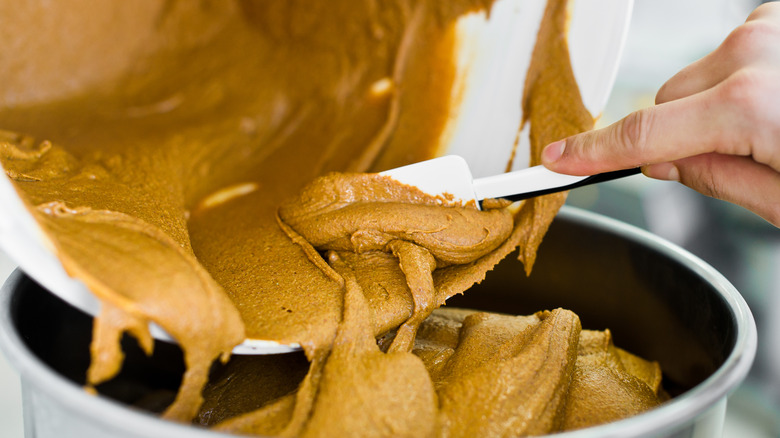When You Eat Peanut Butter With Yogurt, This Is What Happens To Your Body
Sometimes you have go-to pairings with food. Peanut butter on toast, yogurt with granola and fruit slices in it, or even yogurt as a meat marinade. But since the advent of TikTok and bite-size recipes shared enthusiastically online, the world of food seems to have tilted toward the more unusual.
Enter the combo of peanut butter and yogurt, a seemingly famous pairing that boasts hundreds of recipes online. Whether or not it is unusual for you might be questionable. Who knows? Maybe you've already discovered the joys of scooping a tablespoon or two of your favorite brand of peanut butter into Greek yogurt and enjoying it as a snack. Either way, there's a lot that can happen to your body when you eat these two ingredients together.
For starters, they are a powerhouse when it comes to protein, even on their own. In fact, peanut butter has all the nutritional benefits of this animal protein. Two tablespoons of smooth style peanut butter has about 7.1 grams of protein. Meanwhile 100 grams of plain non-fat Greek yogurt has 10.2 grams of protein, per the U.S. Department of Agriculture (regular yogurt has far less protein than Greek yogurt). Proteins are necessary for several reasons. Often referred to as the building blocks of your body, proteins help build and repair muscles, maintain bone health, help make hormones and enzymes, fuel your body, help carry oxygen throughout your body, and play a part in your immune system health.
You'll feel full for longer
Protein helps you feel full for longer, which is why those looking to shed some pounds often up their protein intake. In addition to being the hardest macronutrient to be stored as body fat (when compared with carbohydrates and fats), protein takes longer to digest. The result? You won't be craving a snack in between meals or over-indulge at your next main meal. According to a 2014 study published in the Nutrition Journal, consuming high-protein snacks like yogurt can help with appetite control and satiety. This is when compared with high-fat snacks.
The same is also what happens to your appetite with peanut butter, thanks to the sandwich spread's fiber and healthy fat content. You can get as much as 1.6 grams of fiber from two tablespoons of smooth peanut butter and 16.4 grams of fat (via the U.S. Department of Agriculture), most of which is what is known as healthy fats – monounsaturated and polyunsaturated. It also contains low levels of saturated fat. Fiber and fat also take a long time to digest. As explained by gastroenterologist Dr. Christine Lee (via Cleveland Clinic), "The denser the food, meaning the more protein or fat it has, the longer it takes to digest."
Satiation benefits aside, something else happens to your body when these two foods are combined.
Your gut health might improve
Yogurt is known for its probiotic content — naturally occurring "good" bacteria that are supposedly beneficial for your gut. Although gut bacteria balance and what constitutes "good" and "bad" gut microbiome are still an ongoing area of research, according to a 2013 study published in Therapeutic Advances in Gastroenterology, probiotics influence your gut microbiome by suppressing the growth of harmful bacteria. They are also thought to replace pathogens with "good" gut bacteria.
However, probiotics require the help of prebiotics if they are to work properly, per registered dietician nutritionist Mindy Haar (via Everyday Health). What are prebiotics? They are the food source for your gut microbiome. Foods high in fermentable soluble fiber, resistant starches, inulin, and pectin can all be considered prebiotics. Turns out, peanut butter contains both soluble and insoluble fiber. Another reason to reach for a bowl of yogurt and add peanut butter to it.
Apart from simply combining yogurt and peanut butter and adding granola or fruit to the dish, there are several different recipes you can turn to. TikTok's magic shell yogurt trend is one example. Other options include peanut butter mousse, peanut butter and yogurt fruit dip, and peanut butter and yogurt high-protein frozen cups. Be mindful, however, of food labels. With yogurt, you're looking for specific live probiotic cultures and with peanut butter, you're trying to avoid added sugars and oils. Sticking with one that has the shortest list — just peanuts and some salt — is always best.


